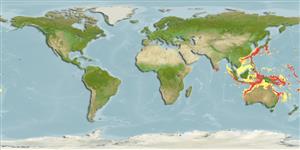Epimenia australis (Thiele, 1987)
| Native range | All suitable habitat | Point map | Year 2050 |

|
| This map was computer-generated and has not yet been reviewed. |
| Epimenia australis AquaMaps Data sources: GBIF OBIS |
Google image |
No photo available for this species.
Classification / Names Common names | Synonyms | CoL | ITIS | WoRMS
Aplacophora | Cavibelonia | Epimeniidae
Environment: milieu / climate zone / depth range / distribution range Ecology
Benthic; depth range 18 - 2000 m (Ref. 1881). Tropical
Distribution Countries | FAO areas | Ecosystems | Occurrences | Introductions
Western Central Pacific and Eastern Indian Ocean.
Length at first maturity / Size / Weight / Age
Maturity: Lm ? range ? - ? cm Max length : 30.0 cm TL male/unsexed; (Ref. 1881)
Life cycle and mating behavior Maturity | Reproduction | Spawning | Eggs | Fecundity | Larvae
Main reference
References | Coordinator | Collaborators
Scheltema, A.H. and M. Jebb 1994 Natural history of a solenogaster mollusc from Papua New Guinea, Epimenia australis (Thiele) (Aplacophora: Neomeniomorpha). Journal of Natural History, 28:1297-1318. (Ref. 1881)
IUCN Red List Status
(Ref. 130435: Version 2025-1)
CITES status (Ref. 108899)
CMS (Ref. 116361)
Threat to humans
Human uses
| FishSource |
Tools
More information
Diet composition
Food consumption
Predators
Max. ages / sizes
Length-weight rel.
Length-length rel.
Length-frequencies
Mass conversion
Abundance
Internet sources
BHL | BOLD Systems | CISTI | DiscoverLife | FAO(Publication : search) | Fishipedia | GenBank (genome, nucleotide) | GloBI | Gomexsi | Google Books | Google Scholar | Google | PubMed | Tree of Life | Wikipedia (Go, Search) | Zoological Record


